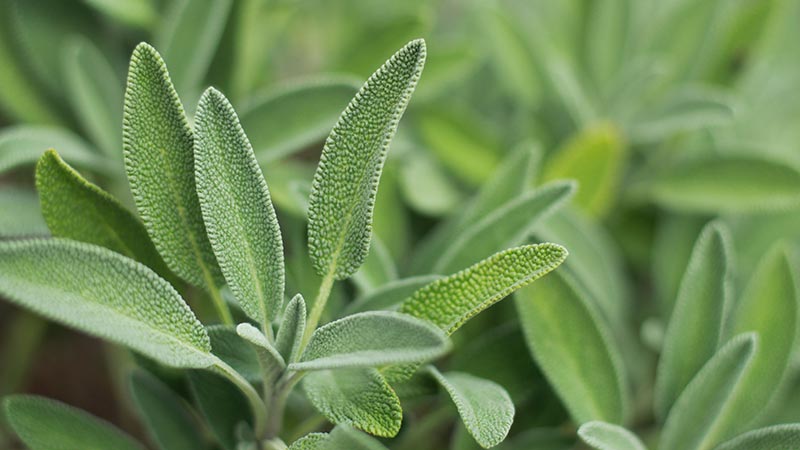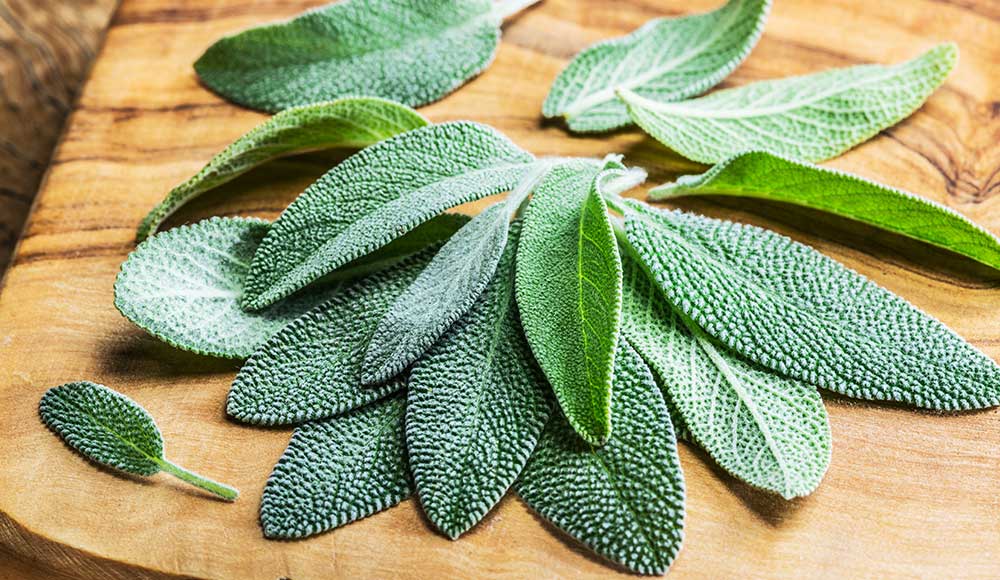By Gilmour
Culinary superstar sage is a pretty, low shrub with pale, velvet-soft greyish green leaves. A member of the mint family, sage is easy to grow and does well in containers, the ground and indoors. If you’re looking to add a new herb to your mix this year, read on to learn everything you need to know about this hardy, versatile plant.
Here, we’ll cover:
What is Sage?
Sage is popular both in the kitchen as well as for what some consider to be medicinal purposes. It’s known as a showstopper in fall dishes, complementing pork and poultry, pairing well with lamb and often used in Thanksgiving stuffing. It’s also the perfect flavor to add to fall and winter squash dishes and risottos. It is both aromatic and flavorful, and can be planted with Mediterranean herbs such as rosemary or basil. Some people believe sage’s medicinal properties may be good for improving memory and helping resolve stomach ailments. In addition to using sage for cooking , there are also some varieties that are purely ornamental.
Popular Types of Sage
There are a mind-blowing 900 species of salvia (which is the largest genus of plants in the mint family). Some of the most popular varieties are:
- Berggarten Sage – Berggarten sage is very similar to the common garden sage in color, look and style of leaves, but it does not bloom.
- Garden Sage – Garden sage is one of the most well-known varieties and is also referred to as “common sage.” It’s hardy and can resist even extreme cold during winters, bouncing back each spring. Soft, greenish silvery leaves with purple-bluish flowers make this herbal addition a pleaser in any garden. May become woody after 3 – 4 years and need to be replaced.
- Golden Sage – Golden sage is a creeping plant and has green and golden variegated leaves. Beautiful in a garden with other plants, as the colors accentuate whatever is planted around it.
- Grape Scented Sage – Grape scented sage is one of the largest-growing varieties, growing up to 8 feet tall by 6 feet wide. This sage actually does not smell like grapes, as the name would imply, but rather has the sweet smell of freesia. Its flowers and leaves will attract hummingbirds and can be steeped to make tea.
- Mealycup Sage – Mealycup sage, the most common version is known as blue salvia, grows about 2 – 3 feet and is most often an annual, depending on the region you’re growing it in. It has lovely purple, white or blue flower spikes and has several varieties such as “Empire Purple” and “Victoria Blue.”
- Mexican Bush Sage – Mexican bush sage is drought tolerant and grows 3 – 4 feet. Despite being able to withstand drought conditions, it’s otherwise a tender perennial with white or purple flower spikes. It’s a nice accent plant.
- Purple Sage – Purple sage plants have purple leaves when young. Also used for cooking, but unlike garden sage, a purple sage bush doesn’t bloom very often.
- Pineapple Sage – Pineapple sage is primarily grown as an ornamental plant, but is also widely thought to have medicinal properties. This perennial grows tubular red flowers and attracts hummingbirds and butterflies.
- Scarlet Sage – Scarlet sage is an annual that really thrives in full sun, but can also withstand some partial shade as long as it’s planted in well-draining soil. It boasts gorgeous scarlet blooms that produce from late spring through the first frost of the year.
- Tricolor Garden Sage – Tricolor garden sage is similar in looks to purple sage, but has uneven white accented leaves, giving it the perception of being “tricolored.”
- White Sage – White sage is also known as bee sage and is used for cooking. Slow growing, the white sage plant is an evergreen perennial shrub that can take up to 3 years to mature and grows to 2 – 3 feet tall.

Steps to Planting Sage Plants
It’s not hard to learn how to grow sage. From where to plant it, to how to get the best results, just follow our simple step-by-step guide to growing sage for years of enjoyment.
- When is the best time to plant sage? Plant sage after the ground temperature reaches 65°F – about 1 – 2 weeks before you have the last frost of the year.
- Should you grow from seeds? If you decide to grow your sage from seed, take note that it will likely take a couple years to fully mature. If you choose to go the seed route, sow indoors for 6 – 8 weeks before the last frost under a plant light. Sage seeds will take about 3 weeks to germinate, and then you can transplant seedlings to your prepared soil. You can also propagate new plants from other cuttings or by layering.
- Choose the right soil. Sage needs sandy, loamy, well-draining soil. You want a pH between 6.0 and 7.0 for optimal growth. Do not over fertilize if you’re growing for culinary purposes – while you may get faster growth, you will likely lose intensity in flavor. If you’re planting in clay soil, mix in organic matter and sand to provide better drainage.
- Where does sage grow? Sage does best in medium to full sun. It can also do well in containers or indoors – just be sure it’s near a sunny window if you’re growing it inside. If you live in zones 5 to 8, your sage will be a hardy perennial. If you’re in the humid zones of 9 or anywhere further south, it will likely be an annual, as it doesn’t tolerate summer humidity and heat very well.
- How to space sage plants. Most sage plants grow in a roundish bush shape, so take care not to plant them too close together so they have room to mature. Space sage plants about 24” apart.
- How much water does sage plant need? Sage is a relatively drought-tolerant herb. Even if it begins to wilt, it will typically perk up with water. Don’t over-water – wait until your soil is dry, and then thoroughly water.
Caring for Sage
Sage is an easy-to-grow plant that doesn’t demand a ton of care. It has a long growing season and is one of the few herbs that doesn’t lose intensity in flavor after flowering. It’s not susceptible to many pest threats, and most often, your only concern may be mildew, which you can avoid by taking care to not overwater.
- How to prune sage? You should prune your sage back in early spring. Be sure to cut past the woody, thick stems to keep your next-season leaves fresh and flavorful.
- How often to water sage. Water sage sparingly. Too much water and you risk mildew. Wait for the soil to completely dry out, then water thoroughly.
- When to harvest sage. Sage can be harvested as-needed. You should clip just above the part of the plant where two leaves meet. Harvest your sage in the morning, after dew has dried. During the first year of growth, harvest lightly to ensure full growth.
- How often to harvest sage. Once or twice during each growing season, do a larger harvest, cutting the stems back no more than about half of the sage plant. Doing so will ensure you have a nice, evenly-shaped plant that’s beautifully round and full.
- How to store sage. For the most fragrant and intense flavor, use your sage fresh. However, you can also dry it for later use or teas. Keep in mind, if cooking with dried sage, the flavor will be much more concentrated. You should adjust recipes accordingly.
- How to dry sage. Drying sage leaves is simple. Cut small bunches, leaving the leaves on the stems, and tie your cuttings together. Hang upside down in a dark, cool, well-ventilated room until bunches are dry and leaves are crisp. Remove leaves from stems and store them whole, crushing as needed.
Common Questions About Growing Sage
Why is my sage plant dying?
The most common reason your sage may be doing poorly is overwatering. Soil should be dry before watering to prevent mildew and yellow or brown spots.
Can sage survive winter?
Sage is a cold-hardy herb. In most regions, particularly zones 5 – 8, most varieties will simply go dormant in the winter and come back the next spring.
How long does sage last?
As long as properly cared for, harvested and pruned every season, your sage plant can last you many years. Some have found that their plants get more and more woody as the years go by, and that by year 3, the plant is no longer as productive or flavorful. However, others note that by cutting back past the woody stems at the end of each growing season, you can get many more years out of this herb.
Is sage annual or perennial?
Actually, both! If you live in planting zones 5 – 8, your sage will be a perennial, growing back year after year each spring. If you’re in zones 9 and further south, your sage will likely be an annual, or one-year plant.



